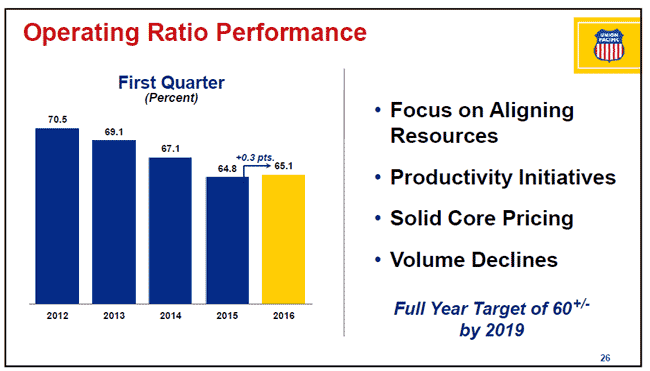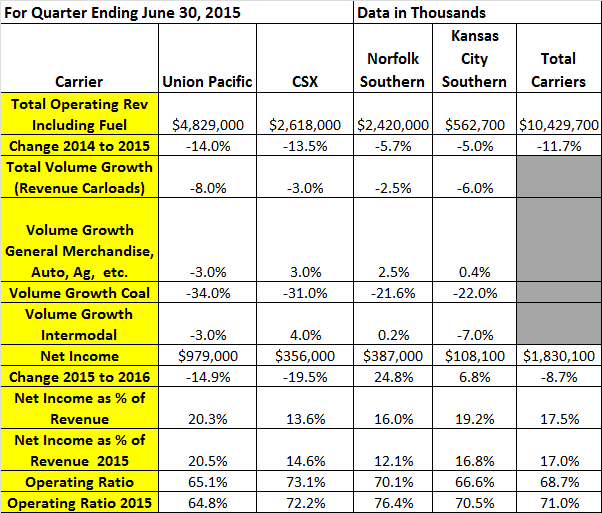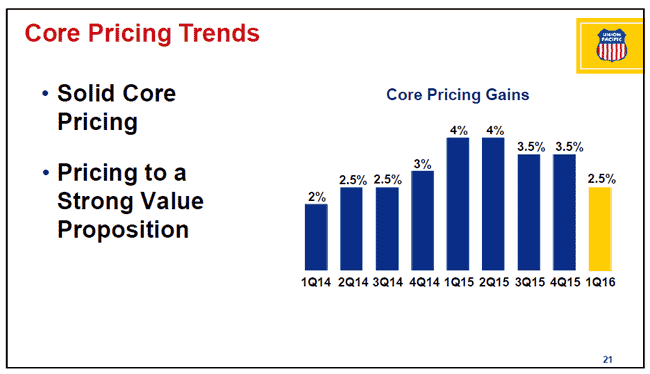Rail carriers battled a soft environment in Q1, with volumes down in the mid-single digit percentages, but somehow most managed modestly strong rate increases and drove still more efficiencies to minimize the impact of that softness on the bottom line.
Supply Chain Digest Says... |
 |
| Union Pacific saw it OR rise slightly in Q1, but still achieved an impressive operating ratio of just 65.1%. |
 |
What do you say? |
| Click here to send us your comments |
 |
| Click here to see reader feedback |
|
|
We're back as usual every quarter with our review of the results and trends across freight modes, starting last week with US truckload carriers (see US Truckload Carriers Have Soft Q1, as Freight Volumes, Rates Mostly Down).
This week, we look at the rail transport sector, and then next week we'll review results and trends in the less-than-truckload group.
As part of that review we look at the four major Class I public carriers that make up the US rail sector (Burlington Northern is of course part of public company Berkshire Hathaway, but its results are not broken out in any detail and thus are not included).
Of late, rail carriers are battling several trends when it comes to volumes. Those include: overall softening freight volumes in the US, perhaps a sign of a weakening economy; continued major declines in freight cars carrying coal; and falling diesel prices, which make truckload carriage increasingly attractive in many lanes, as fuel surcharge costs have plummeted.
According to the Association of American Railroads, total US regular carload traffic for the first quarter of 2016 was 3,143,251 carloads, down 13.8%, while growth in intermodal containers and trailers continued to slow, up just 1.5 percent in the quarter. That left total rail traffic volume in Q1 at about 6.5 million carloads and intermodal units, down 6.5% from the same point last year.
The other big news in the quarter was that Canadian Pacific finally ended its attempted takeover of Norfolk Southern after several attemtps, a move fought by Norfolk Souther and which faced likely resistance from US regulators.
This after CP tried to acquire CSX in 2014 and then it is now reported attempted again recently even while it was going after Norfolk Southern.
"We have long recognized that consolidation is necessary for the North American rail industry to meet the demands of a growing economy," Canadian Pacific’s chief executive, E. Hunter Harrison, said in the statement when it abandoned the Norfolk Southern pursuit - meaning this will likely not be the last we see of Canadian Pacific in terms of takeovers.
Total carloads in the quarter were down for all four carriers, from 2.5% at Norfolk Southern to 8% at Union Pacific. That again is in part due to a another major drop in coal volumes for all of the carriers, in the 20-35% range of decline. General merchandise ranged from down 3% at Union Pacific to up 3% at CSX, which also saw intermodal gains of 4% while the others were flat or down a few percent in that sector.
But despite those sluggish volumes, several of the rail carriers indicated they saw strong pricing environments. Union Pacific said rates were up 2.5% in Q1, while everyone else referenced a "strong pricing" enviornment in Q1 without being specific.
Those rate gains, combined with continued efficiency improvements, meant the bottom lines for the rail carriers held up pretty well. While net income was down 8% for all four carriers combined, profts were up sharply at Norfolk Southern (24.8%) and 6.8% at Kansas City Southern.
Net income as a percent of revenue for the group actually rose a bit, to 17.5% from 17.0% in Q1 2015. That metric at Union Pacific was down a couple of tics in Q1, but was still a very strong 20.3%.
Relatedly, average operating ratios (OR), or operating expense divided by operating revenue, a key metric in the transport sector, were up actually down in Q1 to 68.7% (unweighted average) from 71.0% in 2015, based on strong gains again at Norfolk Southern and Kansas City Southern.
That level of OR is of course far superior to that seen in the truckload or LTL sectors, which generally see ORs in the high 80 percent levels and low 90 levels, respectively.
Union Pacific saw its OR rise slightly in Q1, but still achieved an impressive operating ratio of just 65.1%, as shown below.
Union Pacific's Operating Ratio Performance

Source: Union Pacific
Full Q1 financial results for our group of rail carriers is shown below:
Q1 2016US Rail Carrier Operating Results

(See More Below)
|
CATEGORY SPONSOR: SOFTEON |
|
|
| |
|
|
As usual, we provide a few highlights from the earnings releases of each carrier, though they were even more terse in Q1 than usual.
Union Pacific
Company noted that "solid core pricing and productivity improvements helped to
offset an 8 percent decline in total volumes."
Core pricing was up a solid 2.5% in the quarter, though that was down from recent quarters, as shown in the chart below.

Lower fuel costs negatively impacted the operating ratio by 0.5 percentage points, more than the rise in OR of 0.3 points, meaning outside fuel the operating ratio actually improved in a very soft quarter.
Company says it expects the trends seen in Q1 of "an energy market recession, low commodity prices, the strength of the U.S. dollar in a soft global economy, and muted domestic retail demand" to continue for the rest of 2016.
CSX
Said lower revenues were partly offset by $133 million in unspecified savings from productivity gains in the quarter.
Company said that "we continue to expect full-year earnings per share to decline in 2016 as a result of ongoing coal headwinds combined with other market fundamentals,"
Norfolk Southern
Surprisingly increasing net income by almost 25%, company noted that "the company is now on track to achieve productivity savings of about $200 million and an operating ratio below 70 in 2016."
Norfolk Southern also referenced "higher rates" in the quarter.
Kansas City Southern
Noted results were impacted by flooding that shut down key portions of its U.S. rail network for three weeks.
Also commented that the "Pricing environment continues to be favorable."
Company has 12% of its locomotives in storage due to soft volume market.
Also noted that fuel savings program was key initiative for 2016; applying accelerated capital to expand fuel optimization technology installation in 20% of road fleet in 2016.
Any reaction to the Q1 results and trends from the rail carriers? Let us know your thoughts at the Feedback section below.
Your Comments/Feedback
|